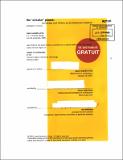| dc.contributor.advisor | Hasan-Uddin Khan.Being related, these individual events would allow for an experiential understanding of the complexity of the 'whole,' acknowledging the infinite or circular relationship between the visible-landscape-body and the invisible-history-mind. | en_US |
| dc.contributor.author | Urma, Ioana Ruxandra, 1972- | en_US |
| dc.contributor.other | Massachusetts Institute of Technology. Dept. of Architecture. | en_US |
| dc.date.accessioned | 2012-04-26T18:41:14Z | |
| dc.date.available | 2012-04-26T18:41:14Z | |
| dc.date.copyright | 2001 | en_US |
| dc.date.issued | 2001 | en_US |
| dc.identifier.uri | http://hdl.handle.net/1721.1/70337 | |
| dc.description | Thesis (M. Arch.)--Massachusetts Institute of Technology, Dept. of Architecture, 2001. | en_US |
| dc.description | Includes bibliographical references (p. 193-203). | en_US |
| dc.description.abstract | Ideas. This thesis attempts to demonstrate that architecture, conceived from human experience, is a dual process of thinking and doing, in addition to being a building or a final product, and can occur at any scale of development (as large as an urban space). The thesis tries to create a strong correlation between things that people experience through the senses - real things, visible - and those that they experience through the mind - imaginary things, invisible. Defined as the great composition of existing materials and forms, the site and everything it encompasses, structures both 'natural' and man-made, landscape represents the visible, which deals with the experience of the body (the senses). Defined as that by which meaning and value is attributed to visible things, history, in the form of thought and memory, represents the invisible, which deals with the experience of the mind. To create a full human experience, a true experience, one must acknowledge that full reality is non-linear. The thesis then mandates that single events be approached from a wholistic perspective. The method by which to deal with the complexity of information gathered through this wholistic process is to act according to feeling by feeding the subconscious with analytical information and translating that information into perceptual representation through metaphor and diagram. Ideas into reality. Piazza Ovidiu, the central focus of the old town of Constanta, Romania has been chosen as the site for the experiment, as it is both rich in invisible historical information and, as a disfunctional post-communist public space, it is in great need of rehabitation. Redefining 'piazza' to be a zone of public interaction, rather than a common open space, the thesis thus proposes that the area be divided into a series of sub-spaces, stories interwoven through the land and through time. Being related, these individual events would allow for an experiential understanding of the complexity of the 'whole,' acknowledging the infinite or circular relationship between the visible-landscape-body and the invisible-history-mind. | en_US |
| dc.description.statementofresponsibility | Ioana Ruxandra Urma. | en_US |
| dc.format.extent | 206 p. | en_US |
| dc.language.iso | eng | en_US |
| dc.publisher | Massachusetts Institute of Technology | en_US |
| dc.rights | M.I.T. theses are protected by
copyright. They may be viewed from this source for any purpose, but
reproduction or distribution in any format is prohibited without written
permission. See provided URL for inquiries about permission. | en_US |
| dc.rights.uri | http://dspace.mit.edu/handle/1721.1/7582 | en_US |
| dc.subject | Architecture. | en_US |
| dc.title | The 'Circular' Piazza : landscape and history as architectural material : Constanta, Romania | en_US |
| dc.title.alternative | Piazza Ovidiu : landscape and history as architectural material : Constanta, Romania | en_US |
| dc.type | Thesis | en_US |
| dc.description.degree | M.Arch. | en_US |
| dc.contributor.department | Massachusetts Institute of Technology. Department of Architecture | |
| dc.identifier.oclc | 48086837 | en_US |
